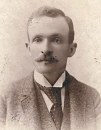|
|
 |
 |
|
Reading Guide |
| 4. |
Charles W. Chesnutt, "The Goophered Grapevine," short story, 1887
|
|
 |
Black-white relationships after the war became a focal point for the African American writer Charles Chesnutt. Born of free black parents in Ohio, and a teacher of freed slaves in North Carolina, he became adept at writing about race for a white audience ("Grapevine" was originally published in the Atlantic Monthly). To our ears his "dialect stories" sound stereotyped and condescending, but Chesnutt knew his audience and his goals. He pursued "a high, holy purpose," as stated in his journal, to promote "recognition and equality" for black Americans.
The narrator in this story is a white northern businessman contemplating the purchase of an abandoned farmstead in North Carolina after the war. Uncle Julius, a former slave on the farm (who appears in several of Chesnutt's stories as a trickster character), relates the story of the farm's bewitched grapevines and recommends against purchasing the farm. As a good story should do, "Grapevine" presents a seemingly light slice of life to reveal the powerful undercurrents in human interchange—here of the Reconstruction South. 8 pages.
Discussion questions
- What resources does Uncle Julius bring to his encounter with the northerner?
- How does Uncle Julius manipulate the northerner while maintaining the submissive demeanor required of him?
- Does Uncle Julius's maneuver fail, or does the story result in a win-win situation?
- How could newly emancipated people exercise power?
- To Chesnutt, what is the relationship between power and freedom? between power and identity?
|
» Link |
 |
 |
Topic Framing Questions
| • |
What challenges did the newly freed African Americans face immediately after the Civil War? |
| • |
What did freedom mean to the newly freed? |
| • |
What resources did recently emancipated African Americans possess as they assumed life as free men and women?
|
| • |
How did African Americans define and exercise power in their first years of freedom?
|
|
|
 |
 |
|
 |
